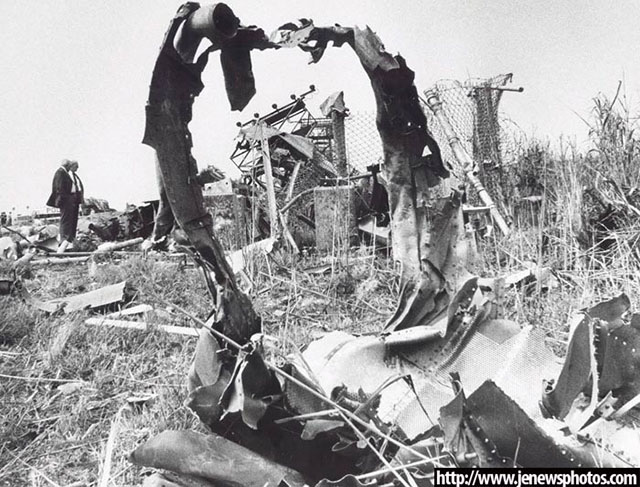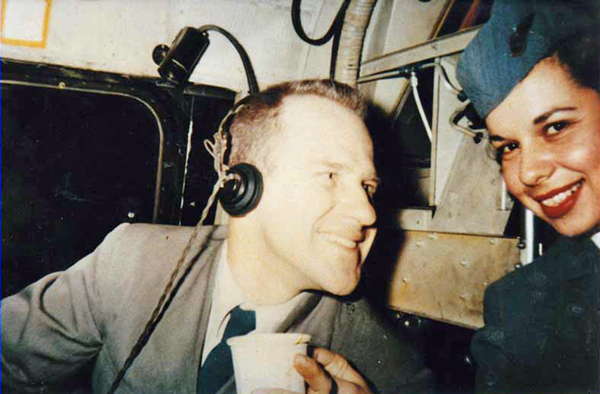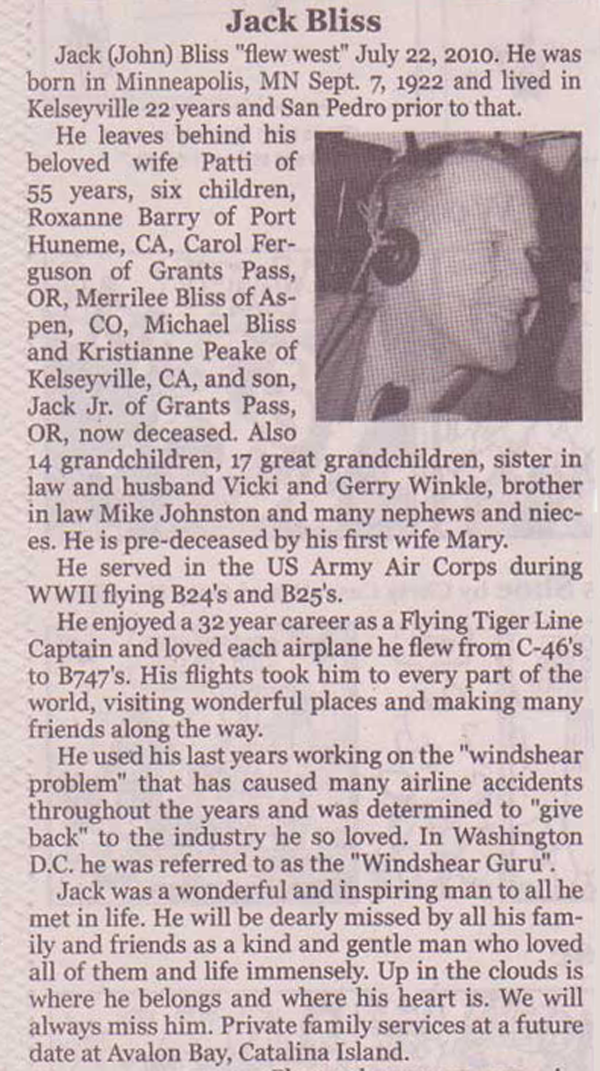This was the deadliest single-aircraft crash in U.S. history at the time, and it was a wake up call to the industry. By 1975 many U.S. based airlines had already seen several disastrous windshear mishaps, including one in Pago Pago just a year previous, where a Pan American World Airways Boeing 707 crashed and killed 97 of the 101 crew and passengers. That mishap, however was blamed on "destabilizing wind changes." While the terminology was still in its infancy, a preceding aircraft used the "windshear" term exactly in a warning to other aircraft. That warning was heard by the crew of Eastern Air Lines flight 66, but it was ignored.
— James Albright

Updated:
2021-06-26
Out of this mishap grew windshear detection technology and a greater emphasis on pilot training. On a personal note, an aircraft that preceded Eastern 66 by just a few minutes pleaded with ground control to change the active runway. I believe the captain on that flight, Flying Tiger Line 161, was the person that taught me the minimum ground speed method. That story here: "Gravity Always Wins."

1
Accident report
- Date: 24 June 1975
- Time: 16:05
- Type: Boeing 727-225
- Operator: Eastern Air Lines
- Registration: N8845E
- Fatalities: 6 of 8 crew, 107 of 116 passengers
- Aircraft Fate: Destroyed
- Phase: Approach
- Airports: (Departure) New Orleans International Airport, LA (MSY, KMSY)
- Airports: (Destination) New York-John F. Kennedy International Airport, NY (JFK, KJFK)
2
Narrative
- Eastern 66 arrived in the New York City terminal area without reported difficulty, and, beginning at 1535:11, Kennedy approach control (Southgate arrival controller) provided radar vectors to sequence the flight with other traffic and to position it for an instrument landing system (ILS) approach to runway 22L at the Kennedy airport. The flight had received a broadcast on the automatic terminal information service (ATIS) which gave in part the 1251 Kennedy weather observation and other data as follows: "Kennedy weather, VFR, sky partially obscured, estimated ceiling 4,000 broken, 5 miles with haze . . . wind 210° at 10, altimeter 30.15. Expect vectors to an ILS runway 22L, landing runway 22L, departures are off 22R."
- At 1551:54, the Southgate arrival controller broadcast to all aircraft on his frequency, ". . . we're VFR with a 5-mile, light, very light rain shower with haze, altimeter check 30.13. . . It's ILS 22L, also." At 1552:43, the controller transmitted, "All aircraft this frequency, we just went IFR with 2 miles very light rain showers and haze. The runway visual range is---not available, and Eastern 66 descend and maintain four thousand, Kennedy radar one three two four.'' Eastern 66 acknowledged the transmission.
- Eastern 66 was one of a number of aircraft that were being vectored to intercept the ILS localizer course for runway 22L. At 1553:22, the flight contacted the Kennedy final vector controller, who continued to provide radar vectors around thunderstorms in the area to sequence the flight with other traffic, and to position the flight on the localizer course. About 1557:21, the flight crew discussed the problems associated with carrying minimum fuel loads when confronted with delays in terminal areas. One of the crewmembers stated that he was going to check the weather at the alternate airport, which was LaGuardia Airport, Flushing, New York. Less than a minute later, one of the crewmembers remarked, ". . . one more hour and we'd come down whether we wanted to or not. At 1559:19, the final vector controller transmitted a message to all aircraft on his frequency that "a severe wind shift" had been reported on the final approach and that he would report more information shortly.
- Eastern Air Lines Flight 902, a Lockheed 1011, had abandoned its approach to runway 22L at 1557:30. At 1559:40, Eastern 902 re-established radio communications with the Kennedy final vector controller, and the flight crew reported, ". . . we had . . . a pretty good shear pulling us to the right and . . . down and visibility was nil, nil out over the marker . . . correction . . . at 200 feet it was . . . nothing." The final vector controller responded, "Okay, the shear you say pulled you right and down?" Eastern 902 replied, "Yeah, we were on course and and down to about 250 feet. The airspeed dropped to about 10 kn below bug and our rate of descent was up to 1,500 feet a minute, so we put takeoff power on and we went around at a hundred feet."
- Eastern 902's wind shear report to the final vector controller was recorded on Eastern 66's cockpit voice recorder (CVR). While Eastern 902 was making this report, the captain of Eastern 66, at 1600:33, said, "you know this is asinine." An unidentified crewmember responded, "I wonder if they're covering for themselves."
- The final vector controller asked Eastern 66 if they had heard Eastern 902's report. Eastern 66 replied, ". . . affirmative." The controller then established the flight's position as being 5 miles from the outer marker (OM) and cleared the flight for an 1LS approach to runway 22L. Eastern 66 acknowledged the clearance at 1600:54.5, "Okay, we'll let your know about the conditions." At 1601:49.5, the first officer, who was flying the aircraft called for completion of the final checklist. While the final checklist items were being completed, the captain stated that the radar was, "Up and off . . . standby." At 1602:20, the captain said, ". . . I have the radar on standby in case I need it, I can get it later."
- At 1602:42, the final vector controller asked Eastern 902, ". . . would you classify that as severe wind shift, correction, shear?" The flight responded, "Affirmative."
- At 1602:50.5, the first officer of Eastern 66 said, "Gonna keep a pretty healthy margin on this one." An unidentified crewmember said, "I . . . would suggest that you do." The first officer responded, "in case he's right."
- At 1602:58.7, Eastern 66 reported over the OM, and the final vector controller cleared the flight to contact the Kennedy tower. At 1603:12.4, the flight established communications with Kennedy tower local controller and reported that they were, "outer marker, inbound. At 1603:44, the Kennedy tower local controller cleared Eastern 66 to land. The captain acknowledged the clearance and asked, "Got any reports on braking action . . . ?" The local controller did not respond until the query was repeated. At 1604:14.1, the local controller replied, "No, none, approach end of runway is wet . . . but I'd say about the first half is wet--we've had no adverse reports.
Source: NTSB AAR-76-08, page 2
- At 1604:38.3, N8845E was nearly centered on the glideslope when the flight engineer called, "500 feet." The airspeed was oscillating between 140 and 148 kn. The sound of heavy rain could be heard as the aircraft descended below 500 feet, and the windshield wipers were switched to high speed.
- At 1604:52.6, the captain said, "I have approach lights," and the first officer said. "Okay." At 1604:54.7, the captain again said, "Stay on the gauges," and the first officer replied, "I'm with it." N8453 then was passing through 400 feet, and its rate of descent increased from an average of about 675 feet per minute (fpm) to 1,500 fpm. The aircraft rapidly began to deviate below the glideslope, and 4 seconds later, the airspeed decreased from 138 kn to 123 kn in 2.5 seconds.
- N8845E continued to deviate further below the glideslope, and at 1605:06.2, when the aircraft was at 150 feet, the captain said, "runway in sight." Less than a second later, the first officer said, "I got it." The captain replied, "got it?" and a second later, at 1605:10.2, an unintelligible exclamation was recorded, and the first officer commanded, "Takeoff thrust." The sound of impact was recorded at 1605:11.4.
Source: NTSB AAR-76-08, ¶1.11
3
Analysis
- Flying Tiger Line Flight 161, a DC-8, had preceded Eastern 902 on the approach and had landed on runway 22L about 1556:15. After clearing the runway, at 1557:30, the captain reported to the local controller: "I just highly recommend that you change the runways and . . . land northwest, you have such a tremendous wind shear down near . . . the ground on final." The local controller responded, "Okay, we're indicating wind right down the runway at 15 kn when you landed. At 1557:50, the captain of Flight 161 said, "I don't care what you're indicating; I'm just telling you that there's such a wind shear on the final on that runway you should change it to the northwest."   The local controller did not respond. At 1557:55, he transmitted missed approach directions to Eastern 902 and asked ". . . was wind a problem?" Eastern 902 answered, "Affirmative."
- The Captain of Flying Tiger 161 stated that during his approach to runway 22L he entered precipitation at about 1.000 feet, and he experienced severe changes of wind direction, turbulence, and downdrafts between the OM and the airport. He observed airspeed fluctuations of 15 to 30 kn and at 300 feet he had to apply almost maximum thrust to arrest his descent and to strive to maintain 140 kn on his inertial navigation system groundspeed indicator. The aircraft began to drift rapidly to the left, and he eventually had to apply 25° to 30° of heading correction to overcome the drift. He believed that the conditions were so severe that they would not have been able to abandon the approach after he had applied near maximum thrust, and therefore he landed.
Source: NTSB AAR-76-08, page 5
- About 8 minutes before the accident, the NWS weather radar located at Atlantic City, New Jersey, showed that an area of thunderstorm activity was centered along the northern edge of Kennedy Airport. The area was oriented west-northwest to east-southwest and was 30 to 35 miles long and about 15 miles wide.
- At the time of the accident, there was no SIGMET in effect for the New York City terminal area.
Source: NTSB AAR-76-08, page 8
- The flight crew died from multiple extreme impact injuries.
- Two flight attendants died of multiple extreme impact injuries. The two flight attendants who survived sustained one or more fractures and multiple contusions and abrasions.
- Most of the passengers died from severe multiple impact injuries.
Source: NTSB AAR-76-08, ¶1.13
- The results of these analyses showed that Eastern 66 probably encountered an increasing headwind as it descended on the ILS glideslope. The wind changed from about a 10-kn headwind at 600 feet to an approximate 25-kn headwind at 500 feet. About the time the aircraft descended through 500 feet, it encountered a downdraft with peak speeds of about 16 feet per second (fps). The headwind diminished to about 20 kn as the aircraft descended to 400 feet, where the speed of the downdraft abruptly increased to about 21 fps, and the headwind suddenly decreased from 20 kn to 5 kn over a 4-second period. During this encounter, the aircraft deviated rapidly below the glideslope. As the aircraft continued to descend toward the ground, the downdraft diminished and the longitudinal wind component continued to decrease.
- Close examination of the wind model disclosed transient periods in which the combination of downdraft speed and the rate-of-airspeed change (caused by the abrupt decrease in the longitudinal wind component along Eastern 66's flight path) might have exceeded the aircraft's static performance capability.
Source: NTSB AAR-76-08, ¶1.16.1
4
Cause
The National Transportation Safety Board determines that the probable cause of this accident was the aircraft's encounter with adverse winds associated with a very strong thunderstorm located astride the ILS localizer course, which resulted in high descent rate into the non-frangible approach light towers. The flight crew's delayed recognition and correction of the high descent rate were probably associated with their reliance upon visual cues rather than on flight instrument reference. However, the adverse winds might have been too severe for a successful approach and landing even had they relied upon and responded rapidly to the indications of the flight instruments."
Source: NTSB AAR-76-08, ¶2.2(b)
5
Postscript
I've been telling this story for thirty years now, perhaps with a tinge of regret. Regret that I never knew who that DC-8 captain was, I wanted very much to contact him one day to thank him. I only caught the tail end of the TV show, I never caught his name or the airline he was flying for. Truth is, I didn't realize just how important this information was until the next day when it saved my life and that of my crew. Over the years I've made efforts, but nobody seemed to know.
Then, in 2015, a magazine I write for asked me to write an article looking at windshear, how we've progressed over the years. So I pulled up the NTSB aviation accident report on Eastern Air Lines 66 and read about a Flying Tiger Line DC-8 captain who landed just prior who worried about his ground speed and pleaded with ground control to change the active runway. I thought this might be the guy. I called the Flying Tiger Line Alumni Association and found out it was him, Captain Jack Bliss.
Here is the email answer I got . . .
Hi James:
My name is George Gewehr and I’m the FTL historian and ex President of the association. The Captain you are asking about was Jack Bliss. He has flown west several years back, I’m thinking six years ago. If he were still here he would have loved to have heard your story. I have a news paper clipping of him with an attached article to it. Just coincidentally I was at Jfk when he landed. I had arrived from the west coast about forty minutes before Jack had landed. I had passed the very storm over the Sparta VOR that later hit JFK. When we were on the ground we were in the Tiger building and it hit us. It was a HELL of a thunder storm and moving very fast. I was sitting in our operations office when his copilot walked in and sat down next to me. I was startled to see him and asked him, “Where in hell did you come from” He said he just landed with Jack Bliss and that Eastern Airlines had crashed behind them. Jack had a load of live cattle on board his airplane. Needless to say the airport was closed for a while until JFK could sort things out. Hope that helps you in your search.
Sincerely, George Gewehr
I think it is very important for pilots to have mentors and aviation heroes. It gives us something to aspire to and something to inspire us to learn and become better than we are. I've never met my mentor, but I will never forget him either.
References
(Source material)
NTSB Aircraft Accident Report, AAR-76-08, Eastern Air Lines, Inc., Boeing 727-225, N8845E, John F. Kennedy International Airport, Jamaica, New York, June 24, 1975.


